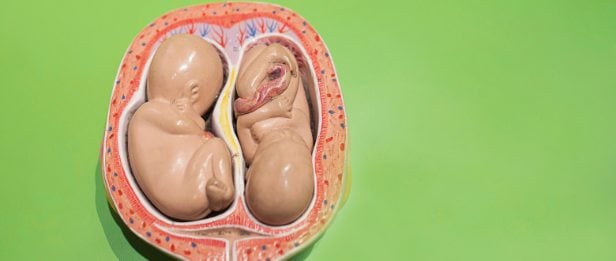Alisha and Jai Verma were ecstatic when they learned they were going to have twins. “We were excited, and yes, we also thought we would be completing our family in one go!” recalls Alisha.
“Little did we know how hard a twin pregnancy would be and the onslaught of changes it would bring.”
How is twin pregnancy different?
A twin pregnancy is different in many ways. Women are likely to gain more weight and also experience pronounced changes in their physical and mental health.
Women carrying twins are at a higher risk of
- Hypertension
- Gestational diabetes and
- Severe morning sickness (hyperemesis gravidarum)
You may experience pressure symptoms of pregnancy like swollen ankles, hemorrhoids (piles), fatigue and backaches. These tend to occur by the end of the second trimester.
Twins are also at a risk of
- Being born prematurely
- Intrauterine growth restriction or growth delays, where one twin grows slower than the other
You will be recommended frequent ultrasound scans, beginning from the second trimester, as there is a greater risk of complications with a twin pregnancy.
Is a twin pregnancy considered high risk?
Yes, a twin pregnancy is considered high risk because of the increased chances of complications.
Alisha and Jai were extensively counseled by their gynecologist, Dr. Anita Sabherwal Anand, about their high risk pregnancy.
Keen on learning more, the couple inquired about which parent carries the gene for twins.
How does a twin pregnancy occur?
A twin pregnancy can occur if
- Two eggs are released during ovulation and each egg is fertilized by a sperm (fraternal twins) OR
- One fertilized egg splits into two embryos (identical twins)
“Twin or multiple pregnancies are relatively more common in women older than 35 years or those who have undergone fertility treatment to get pregnant,” says Dr. Anita.
“You may also have twins if the mother’s side of the family has a history of twins. “
What are the symptoms of twins in early pregnancy?
Some women with a twin pregnancy may experience severe nausea and tenderness in the breasts. Women also tend to gain weight faster.
Despite the symptoms of a twin pregnancy, the only way to confirm it is through an ultrasound, usually around 10-12 weeks.
“The scan can assess the number of amniotic sacs, placentas and embryos, and determine whether they are fraternal or identical twins.”
What are twin pregnancy types?
The type of twins depend on the ‘chorionicity’ or the number of placentas, and can be categorized as:
- Dichorionic diamniotic wherein the two embryos each have their own placenta ,chorion (outer membrane) and amniotic sac.
- Monochorionic diamniotic occurs when embryos have a common placenta and chorion but two amniotic sacs. These embryos are identical twins.
- Monochorionic Monoamniotic, though rare, is when the embryos have a shared chorion, placenta and amniotic sac.
The risk of complications depends on the type of twin pregnancy.
Though now apprehensive about the pregnancy, the couple wanted to be well informed about what to expect in the upcoming months. They asked about possible risks.
What are the twin pregnancy complications?
The mother is at an increased risk of developing
- Anemia, owing to the consumption of iron by the twins during pregnancy
- Gestational diabetes, where the body isn’t able to cope with the sugar produced
- Hypertension or Preeclampsia, which could pose harm if not treated on time
- Intrahepatic cholestasis of pregnancy (ICP) in which the function of the liver is affected
- Deep vein thrombosis or formation of blood clots in the legs or pelvic area
- Depression, owing to bodily changes or stress
Either of the babies also have a higher chance of
- Low birth weight or restricted fetal growth, sometimes called selective growth restriction, in which one twin grows slower than the other
- Premature birth, which occurs in about 60% of twin pregnancies and is associated with breathing problems and limited organ development
- Twin to Twin Transfusion Syndrome (TTTS), where one twin receives less blood than the other twin, particularly in the case of a shared placenta
- Miscarriage, either due to chromosomal abnormalities, growth delays, TTTS, or vanishing due to the Vanishing twin syndrome, the exact cause of which is not known
The doctor noted the couple’s troubled faces and assured them that they would be well supported throughout the journey.
The couple calmed down a little when they understood that their antenatal visits would include sessions with a Women’s Health Educator and a physiotherapist who would guide them on their diet and physical activity respectively in addition to their check ups with their gynecologist.
Alisha asked about the frequency of their prenatal visits.
How often are prenatal visits needed?
The frequency of visits depends on the chorionicity of the twins:
- For babies sharing a placenta, ultrasounds are required fortnightly from 16 weeks
- For babies with their own placenta, ultrasounds after every month from 20 weeks
Mothers carrying twins who share an amniotic sac may be advised care from a fetal medicine specialist as well.
The doctor informed the couple that their twin pregnancy would be closely monitored by the maternity team in collaboration with a fetal specialist if required.
Alisha, wanting to be cautious, yet hopeful, asked whether a cesarean was imminent.
What is the mode of delivery with twin pregnancy?
The mode of delivery for a twin pregnancy depends on the presentation of the twins.
“We usually wait for the mother to go into labour and monitor her continuously in the labour room,” shares Dr. Anita.
“If both babies are in a head down position and seem to be doing well, we encourage mothers to try for a vaginal birth. “
“Sometimes, after one twin is delivered, the other twin moves into another position, making a vaginal delivery difficult, but not impossible. In such cases, sometimes, the second twin may require a cesarean delivery.”
“Cesarean deliveries are higher in twin pregnancies abnormal presentations, discordant growth in babies, medical complications and in monochorionic monoamniotic twins.”
Hearing those words gave Alisha a ray of hope and she gathered the courage to ask how she could prepare for a vaginal birth.
How can I prepare for a normal delivery with twin pregnancy?
- Eat as advised: Your nutritional requirements will depend on your pre-pregnancy BMI, and so it is important to not get carried away thinking you should eat double the normal amount. Get advice specific to your needs by a professional trained in nutrition and pregnancy.
- Walk for 40: Get into a routine of walking for a minimum of 30-40 minutes daily and then increase it upto an hour as you become comfortable. This will help you stay in shape and also build your physical endurance.
- Pre-plan visits: Schedule your visits in advance if possible, so that you don’t have to rush into making last-minute appointments. This will save you time and tension.
- Ask for information: Read up about the benefits of normal delivery and talk to your maternity team to learn more about childbirth. The more you learn, the more prepared you will feel. Enroll in childbirth/Lamaze classes and antenatal sessions that can teach you exercises and techniques to deal with labour and face your fears with confidence.
The couple felt at ease after hearing the gynecologist’s advice.
Their ultrasound confirmed they had twins, each with their own placenta and amniotic sac. The couple scheduled their appointments well in advance so they could focus on maintaining an active lifestyle throughout the pregnancy and prepared to meet their twins in a matter of months.
This article has been written in close collaboration with Dr. Anita Sabharwal Anand, practicing obstetrician-gynecologist for 20+ years.

Medically Reviewed by Dr. Anita Sabherwal Anand
MBBS, Lady Hardinge Medical College, University of Delhi (1992); MD (Obstetrics & Gynaecology), Lady Hardinge Medical College, University of Delhi (1997); DNB Secondary (Obstetrics & Gynaecology), National Board of Medical Education, New Delhi (1999)
You May Also Like:
- Vomiting during Pregnancy: 5 Effective Remedies for Morning Sickness
- 9 Pregnancy Tips to Keep in Mind These Nine Months
- Premature Baby Care: How Should Parents Handle Preterm Births?
Liked this article? Follow us on Facebook, Twitter, Youtube and Instagram for more content!


